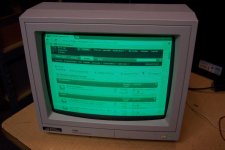Hugo Holden
Veteran Member
I have been looking at the idea of fitting an IBM EGA card to my 5155. The card does not support composite video. But the 5155 uses an internal composite monochrome monitor, receiving its output from the CGA card. Looking at the CGA's schematic the monochrome composite signal is derived in the usual way (common to early Atari video games) by XOR'ing the H & V sync pulses and mixing those resistively with proportions of the red ,green and blue signal to create a composite luminance signal.
Why did IBM drop this output from their EGA card ?
It appears though that all the information is present on the feature connector of the EGA card, R,G & B to mix together and H & V retrace from which I could organize composite H&V sync pulses to generate a monochrome composite signal. Did IBM or any third party sell a feature adapter that did this and is any information available on it ?
One concern is that it would be necessary to keep the EGA card out of the 24kHz high scan rate mode as the H sync circuits in the 5155's internal monitor could not lock to that, but I think its a conventional free running H scan circuit in the 5155's internal monitor, like an ordinary TV monitor, so it would not be damaged.
Also the ATI wonder 400 EGA card appears to have a composite output already there, so what happens to the H scan (sync frequency) rate on that composite output when the EGA card is in the 24kHz mode, does it maintain the usual rate around 15kHz ?
Finally, there is one EGA card which is short and will work in slot 8 as it has a jumper for this, this is the VEGA card from Video-7. Also it is said to be able to coexist with the CGA card. With two cards in situ would they display graphics simultaneously, thereby allowing the continued use of the composite connector on the existing CGA card ?
Why did IBM drop this output from their EGA card ?
It appears though that all the information is present on the feature connector of the EGA card, R,G & B to mix together and H & V retrace from which I could organize composite H&V sync pulses to generate a monochrome composite signal. Did IBM or any third party sell a feature adapter that did this and is any information available on it ?
One concern is that it would be necessary to keep the EGA card out of the 24kHz high scan rate mode as the H sync circuits in the 5155's internal monitor could not lock to that, but I think its a conventional free running H scan circuit in the 5155's internal monitor, like an ordinary TV monitor, so it would not be damaged.
Also the ATI wonder 400 EGA card appears to have a composite output already there, so what happens to the H scan (sync frequency) rate on that composite output when the EGA card is in the 24kHz mode, does it maintain the usual rate around 15kHz ?
Finally, there is one EGA card which is short and will work in slot 8 as it has a jumper for this, this is the VEGA card from Video-7. Also it is said to be able to coexist with the CGA card. With two cards in situ would they display graphics simultaneously, thereby allowing the continued use of the composite connector on the existing CGA card ?


